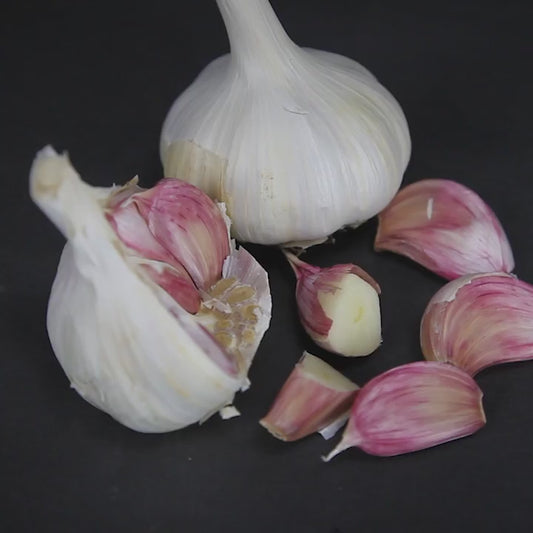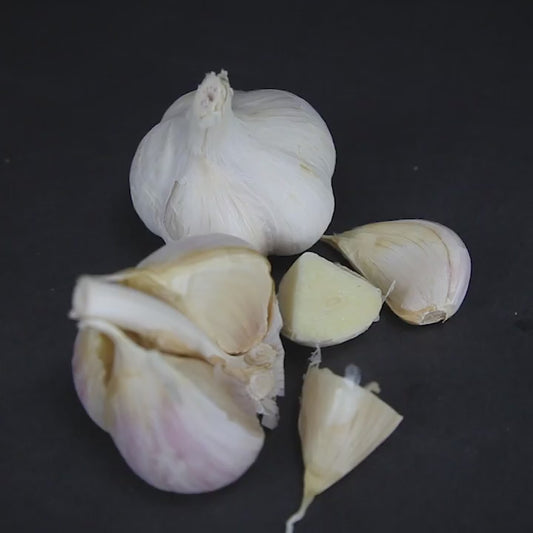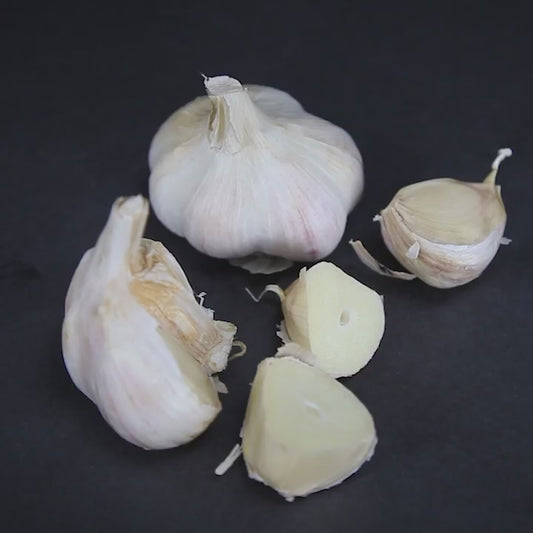Introduction
Garlic is more than just a kitchen essential—it’s a crop full of history, diversity, and rich flavors that can transform your cooking. When you grow garlic at home, you get to explore different types of garlic and flavors you’ll never find in grocery stores. One of the first things to learn is the difference between hardneck and softneck garlic, as each type offers distinct qualities in flavor, storage, and growing habits.
Whether you prefer the bold, complex taste of hardneck garlic varieties or the mild, long-storing nature of softneck garlic varieties, choosing the right type for your climate and cooking needs will set you up for a flavorful harvest.
This guide breaks down hardneck vs softneck garlic—covering their characteristics, how to grow garlic successfully, the best varieties to plant, and how to harvest and store your bulbs. If you want even more tailored help, check out our Garlic Resource Center and Garlic Selector Tool for a customized garlic list matched to your climate, gardening style, and flavor preferences.

Understanding the Difference Between Hardneck and Softneck Garlic
The difference between hardneck and softneck garlic comes down to structure, flavor profile, and growing requirements.
- Hardneck Garlic (Allium sativum ssp. ophioscorodon)
- Hardneck garlic features a stiff central stalk and produces fewer, larger cloves with a strong, spicy flavor. Ideal for colder climates, it’s cold hardy and forms edible garlic scapes—perfect for stir fries and sautés. Hardneck varieties typically have a shorter storage life than softneck types.
- Softneck Garlic (Allium sativum ssp. sativum)
- Softneck garlic, commonly found in grocery stores, has more tightly packed cloves and no rigid stalk. It stores longer, has a milder flavor, and thrives in warmer climates. Since it doesn’t produce scapes, it’s lower-maintenance and easy to braid.
Hardneck Garlic Varieties
If you want strong flavor and robust cloves, hardneck garlic seed is the way to go. Some top picks include:
- Siberian Garlic – Cold hardy with a rich, earthy flavor.
- German Extra Hardy – Large porcelain-type bulbs with a spicy edge.
- Chesnok Red – A purple stripe variety known for its sweet, rich flavor when roasted.
- Purple Stripes – Classic hardneck types with vibrant streaked skins and complex flavors.
Browse all hardneck garlic seed here.
Softneck Garlic Varieties
Organic softneck garlic is ideal for gardeners seeking versatility and long storage life. Recommended options:
- California Early White – Mild flavor, early harvest, great for braiding.
- California Late White – Stronger flavor, heat-tolerant, stores exceptionally well.
- Organic Inchelium Red Garlic – Mild, award-winning flavor with beautiful skins.
- Organic Purple Italian – Rich taste, excellent for roasting.
Shop all softneck seed garlic.
What About Elephant Garlic?
Despite its name, Elephant garlic (Allium ampeloprasum) is more closely related to leeks than true garlic. Its massive bulbs have a mild, onion-like flavor, making them great for roasting whole or adding subtle garlic notes to dishes. Kids especially love harvesting these giants.
Botanical Differences
Bulb Structure
- Hardneck: Fewer, larger cloves arranged around a central stalk. Thin skins make peeling easy but reduce storage life.
- Softneck: Many smaller cloves in layers around a soft neck, tightly wrapped in papery skins that extend shelf life.
Clove Arrangement
Hardneck cloves are symmetrically spaced around the stalk, while softneck cloves are more irregular in size and placement.
Scape Development
Hardneck garlic produces garlic scapes, curly green flower stalks with a mild, garlicky bite. Softneck garlic doesn’t produce scapes, directing more energy into bulb growth.
Flavor Profile
Hardneck garlic offers a spicier, more complex flavor—especially in varieties like purple stripe, which vary by region and soil. Softneck garlic is milder and sweeter, making it ideal for dishes needing a gentler garlic taste.
Chefs often choose hardneck garlic for bold or raw recipes, while softneck is preferred for its long storage life and everyday cooking.
How to Grow Garlic
If you’re new to garlic gardening, start with our detailed guides:
Planting Time
- Hardneck garlic: Best planted in fall (mid-October in most colder climates) so it can establish roots before winter.
- Softneck garlic: Gardeners in mild-winter regions can plant it in either fall or early spring.
Planting Steps
- Loosen the soil 8–10 inches deep and enrich with compost.
- Separate bulbs into individual cloves, leaving papery skins intact.
- Plant cloves 2 inches deep, root side down, spacing 4–6 inches apart.
- Mulch to insulate and suppress weeds.
Garlic Care
- Water evenly but avoid soggy soil.
- Remove scapes from hardneck varieties to encourage larger bulb growth.
- Weed regularly and mulch to retain soil moisture.
For fall care tips, see How to Care for Garlic Over the Winter.
Harvesting Garlic
Knowing when to harvest is key. Check out our full guide on harvesting your garlic.
- Softneck garlic: Ready when the lower leaves brown but upper leaves remain green—often in early summer.
- Hardneck garlic: Harvest when about half the leaves have browned.
- Use a garden fork to gently loosen the soil before lifting bulbs to avoid damage.
After harvesting, cure garlic in a dry, shaded, well-ventilated place for 2–3 weeks before trimming roots and stalks.
Storing Garlic
Store bulbs at 60–65°F with moderate humidity. Use multipurpose mesh tubing or paper bags for airflow. For precise conditions, a digital thermometer/hygrometer can help monitor storage spaces.
Still Can’t Decide?
The Garlic Combo Pack is perfect for gardeners who want to explore both hardneck and softneck garlic varieties in one season—plus shallots for added variety.
Or, if you're seeking a complete starter solution, check out the Down to Earth Organic Garlic Growing Kit for everything you need to grow garlic successfully.
Conclusion
Choosing between hardneck and softneck garlic comes down to climate, flavor, and storage. Hardneck varieties thrive in colder regions with bold taste and scapes, while softneck garlic is ideal for warmer climates and longer shelf life.
Understanding the difference between hardneck and softneck garlic helps you grow what suits your kitchen and garden best. Try bold Chesnok Red or mild California Early White—and even explore wild garlic for something different.
Plant healthy garlic cloves at the right time in the growing season for a flavorful, reliable harvest.









28 comments
Ann, elephant garlic will grow in your zone. It is not actually a true garlic, but rather a member of the leek family. Softneck varieties do well in warmer zones and if you want to grow hardneck garlics, you will want to put it in the refrigerator for a couple of weeks before you plant, since it requires more chill than softnecks.
Hi Grow Organic – I am interested in growing garlic in the Fall. I live in Houston, TX (Zone 9a). What type of garlic do you recommend? Does elephant garlic grow well in 9a? Thanks.
Christine, you can grow hardneck or softneck in zone 8a. I live in zone 9a and we get cold enough to grow hardnecks. I prefer hardnecks over softnecks (easier to peel and more robust flavor), so I really think you should grow for the flavor you want, if you need long storage then softnecks or elephant garlic are a better choice.
Should I be growing soft neck garlic in zone 8a? Thank you.
Janice, In your zone you can grow hardneck garlic with no problem. Softnecks should grow there as well, however, they are more suited to warmer winter zones. I would look at the hardnecks and choose the one that best suits your tastes…mild or spicy.